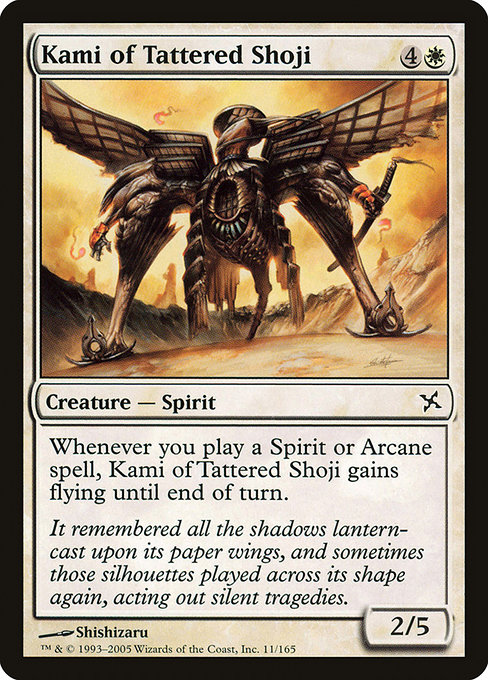
Image courtesy of Scryfall.com
Traditional vs Digital Illustrations in MTG: A Kami Case Study
Magic: The Gathering has always lived at the intersection of storytelling, strategy, and art. The visual language of the game guides how we imagine battles in a world of planes and politics, and few cards illustrate that dialogue as vividly as Kami of Tattered Shoji. This white Spirit from Betrayers of Kamigawa (the 2005 set that braided neon ink with ink-stained ink) anchors a contrast that plenty of players feel in their bones: the tactile, brush-stroked warmth of traditional painting versus the crisp, luminous precision of digital illustration. 🧙♂️🔥
The creature itself is a 2/5 for a mana cost of {4}{W}, a sturdy frame for a spell-heavy white deck. Its ability—“Whenever you cast a Spirit or Arcane spell, this creature gains flying until end of turn”—speaks to Kamigawa’s long-running theme of spirits and human rituals colliding with arcane energies. You can imagine the artwork as a bridge between tradition and the modern, where the shoji-screen-inspired silhouette becomes a vessel for a modern, spell-crafting meta. The artist, Shishizaru, brings a delicate balance of line work and soft texture that invites a second look, whether you’re reading the card on paper or tile by tile on a digital screen. The flavor text, about memory and silhouettes on paper wings, reinforces that sense of fragile, beautiful memory—exactly the kind of poetic tension that both media can capture, just in slightly different decibels. 🎨💎
When we compare the two mediums, several contrasts emerge. Traditional MTG art often leans into tactile brushwork, textured surfaces, and a painterly glow that feels warm in a sleeve or glass case. The Kami piece leans into a quiet, almost sumi-e-inspired linework with a soft, almost cloth-like texture that evokes a shoji screen—perfect for a plane where paper and spirit are the main characters. Digital illustration, on the other hand, can push into sharper contrasts, glow effects, and crisp geometry—elements that can feel more cinematic on a screen. In the case of this card, the traditional approach lends atmosphere: you can feel the hush of a moonlit Kamigawa night, the air thick with parchment and whispered prayers. It’s the kind of image that rewards a slow gaze and a long memory. 🧙♂️⚔️
“The art breathes with the memory of ink on rice paper, and in digital polish it becomes a lantern you can carry in your pocket.”
But the story isn’t only about aesthetics. The production realities of 2005—the year Betrayers of Kamigawa released—meant artists were often working with analog tools, pagination constraints, and the constraints of printing technology. The Kami of Tattered Shoji demonstrates how a traditional approach can capture subtle textures and ambiences that feel almost tangible. In digital environments, that same image could be enhanced with targeted light, micro-textures, or layered glows to emphasize the Spirit’s ethereal wings. Both routes have their place in a collector’s gallery and a deck’s battlefield, and both contribute to the card’s enduring charm. 🎲
From a gameplay perspective, illustration style can subtly influence how players perceive a card’s role. The upshot with Kami is that its flying trigger is momentary but meaningful, a small vessel for grand plans. You can weave it into a Spirit or Arcane-theme deck without sacrificing the integrity of the white mana curve. The card’s rarity—a common with foil and nonfoil finishes—also hints at its accessibility in casual play, which is good for showcasing both media. The tangible warmth of a traditional print can feel different in hand, while the crisp clarity of a digital rendering can make it a standout on a modern monitor during deck-building sessions. Either way, the image reinforces the idea that tradition and innovation can both carry a story forward. 💎
In today’s MTG, digital illustration has become a powerful tool for iteration and experimentation. Artists can test color palettes, adjust lighting, and explore dynamic angles before committing to print. Yet there is something irreplaceable about the first brush or ink stroke captured in a gallery-laden print run. Kami of Tattered Shoji sits at that crossroads, offering a gentle argument for both paths. The paper-wing silhouette reminds us that even in a world of spell-slinging speed, there is room for patience, homage, and a little ceremonial reverence—the core of why we collect these cards in the first place. 🧙♀️🎨
If you’re curious to explore more cross-media comparisons, you can peek into broader conversations around MTG art and its evolving techniques on related articles and histories. For instance, you might compare how environments like digital marketplaces and fan wikis reflect the evolving aesthetics—an ongoing dialogue between nostalgia and novelty. The five articles linked below offer a broader panorama of the cultural web MTG sits in, from board-control concepts to collectible data, and even the nerdy joy of block-by-block stat tracking. 🔍🧭
Phone Grip Click-On Adjustable Mobile Holder KickstandMore from our network
- https://crypto-acolytes.xyz/blog/post/port-town-enables-repeatable-tap-effects-for-board-control/
- https://wiki.digital-vault.xyz/wiki/post/minecraft-block-stats-light_blue_concrete_powder/
- https://wiki.digital-vault.xyz/wiki/post/pokemon-tcg-stats-jellicent-card-id-bw7-45/
- https://blog.crypto-articles.xyz/blog/post/nft-data-gold-bar-811-from-solana-gold-bars-collection-on-magiceden/
- https://crypto-acolytes.xyz/blog/post/nft-stats-non-fungible-token-2666-from-non-fungible-tokens-collection/

Kami of Tattered Shoji
Whenever you cast a Spirit or Arcane spell, this creature gains flying until end of turn.
ID: dc6deb57-4ee3-4716-8644-28283704f994
Oracle ID: a7cb1da6-e56a-42b6-8087-cf822783373f
Multiverse IDs: 74460
TCGPlayer ID: 12292
Cardmarket ID: 12850
Colors: W
Color Identity: W
Keywords:
Rarity: Common
Released: 2005-02-04
Artist: Shishizaru
Frame: 2003
Border: black
EDHRec Rank: 29190
Set: Betrayers of Kamigawa (bok)
Collector #: 11
Legalities
- Standard — not_legal
- Future — not_legal
- Historic — not_legal
- Timeless — not_legal
- Gladiator — not_legal
- Pioneer — not_legal
- Modern — legal
- Legacy — legal
- Pauper — legal
- Vintage — legal
- Penny — legal
- Commander — legal
- Oathbreaker — legal
- Standardbrawl — not_legal
- Brawl — not_legal
- Alchemy — not_legal
- Paupercommander — legal
- Duel — legal
- Oldschool — not_legal
- Premodern — not_legal
- Predh — legal
Prices
- USD: 0.09
- EUR: 0.08
- EUR_FOIL: 0.26
- TIX: 0.04
More from our network
- https://blog.crypto-articles.xyz/blog/post/top-metang-partners-for-a-psychic-metal-tcg-deck/
- https://blog.rusty-articles.xyz/blog/post/quality-driven-loyalty-90-second-uv-phone-sanitizer-and-wireless-charger/
- https://articles.zero-static.xyz/blog/post/how-the-sims-2-stacks-up-against-competitors-on-pc/
- https://crypto-acolytes.xyz/blog/post/how-to-use-bitcoin-atms-quick-safe-steps/
- https://wiki.digital-vault.xyz/wiki/post/pokemon-tcg-stats-pupitar-card-id-sm7-75/
